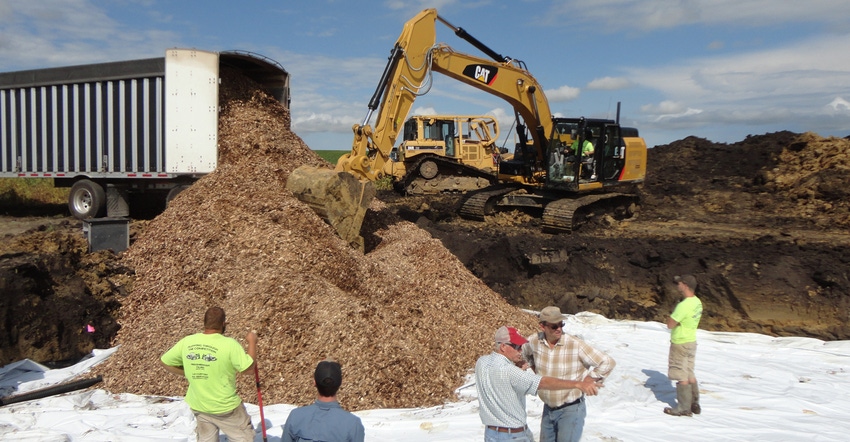March 3, 2020

A recent study measured the role 4R Plus practices like wetlands and cover crops play in reducing flooding risks in the Middle Cedar River watershed. Kris Johnson, deputy director of agriculture for North America for The Nature Conservancy, is one of the authors of the study. He says agriculture holds solutions to issues urban areas face, such as flooding.
4R Plus involves using precise 4R nutrient management along with conservation practices to enhance soil health and improve water quality. As a community of scientists, Johnson says they are interested in finding ways to demonstrate how such practices provide benefits on and off the farm.
“We want to build evidence of the benefits of various 4R Plus practices,” Johnson says. “We know that cover crops reduce nutrient loss and improve soil structure, but we haven’t seen a lot of research that shows the impacts these practices have on urban areas.”
Gathering data, measuring results
Johnson and his colleagues conducted this study and others to measure the benefits 4R Plus practices used by farmers can provide to urban areas.
The study, led by researchers at the University of Iowa Department of Geographical and Sustainability Sciences and the Iowa Flood Center, determined that if practices like wetlands and cover crops were used on a larger scale, the increased soil infiltration and water storage would reduce flooding within the watershed, potentially avoiding hundreds of thousands of dollars in damage to property each year.
“The addition of 4R Plus practices has the potential to change the way water moves on the landscape,” Johnson explains. “This study is a first step in providing evidence that within watersheds, the more practices that are added, the more benefits to farmland and the surrounding communities.”
Involvement in watershed activities
Black Hawk County farmer Nick Meier is active in the Miller Creek watershed, which is part of the Middle Cedar River watershed in eastern Iowa, where the study occurred. He’s interested in the on- and off-farm benefits of 4R Plus practices because he sees the benefits on his farm as well as his neighboring community of La Porte City.
Meier encourages farmers to think about the economic benefits for the farm, as well as their communities, when considering new practices. He encourages farmers to consider the 4R Plus practices that improve soil health and land values.
He changed his tillage practices 30 years ago when he saw soil moving off the farm during heavy rain events. “I switched to no-till and strip till to protect against erosion. I want the soil to be there now and for future generations,” he says. “It bothers me when I drive through farm country and see soil moving off the farm. We need to be doing a better job of preserving our natural resources.”
Working with watershed coordinators
When explaining his passion about soil and water conservation to other farmers, Meier talks about his mindset shift and the success he has working with his watershed coordinator to implement practices. “Because it’s always been done a certain way doesn’t mean that way needs to continue,” he says. “My yield curve continues to rise, and through extensive testing, I know the organic matter is rising.”
Clark Porter, the Miller Creek watershed coordinator, says working with farmers keeps him rooted in his farming background. “We have shared values in regard to conservation and the legacy we’re leaving to future generations,” he says. “It’s rewarding to work with farmers who want to leave the land in better shape and see the benefits to their community.”
Five years ago, Meier began experimenting with cover crops, and now this practice is used on all his acres except for a small portion that’s enrolled in Soil Health Partnership trials so progress can be tracked. “I’m seeing carbon improvements and more earthworms, which greatly improves water infiltration,” he notes.
Gaining peace of mind
Soil testing helps Meier make nutrient decisions that provide a significant cost savings while maintaining an upward yield curve. Several years ago, he installed a bioreactor and a saturated buffer for additional peace of mind. He’s in the final planning stages for constructing a wetland.
Cover crops and other conservation practices, along with nutrient management practices such as the 4Rs (applying right source, at right rate, at right time, in right place) indeed make a difference, he says.
Water coming out of the denitrifying bioreactor is sampled and tested, and has shown a significant decrease in nitrate content. His 2019 data showed water going into the bioreactor at 6.7 ppm and coming out at 2.2 ppm. This system is working, he notes. The benefits are economic for the farmer and environmental for the land and water.
“I feel strongly about the benefits 4R Plus practices have for my farm and my community,” Meier adds. “I’ve learned that building organic matter helps the soil hold more water to support the crops and reduce flooding impacts.”
Meier encourages farmers to attend meetings to learn how they can leave an impact in their watershed. “My hope is more farmers catch on to the good work being done in their watersheds and will want to get involved and add the practices that improve their soil and have a lasting legacy on their community.”
For more information, visit 4rplus.org.
About the Author(s)
You May Also Like






